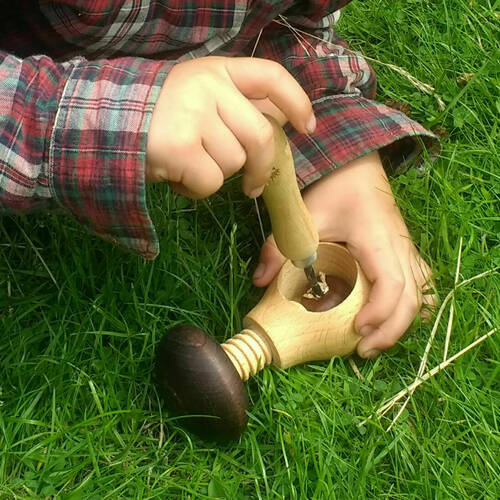
Drilling conkers
An easy introduction to drilling that can result in some amazingly creative pieces of art.
Read More about Drilling conkersPalm drills are perfect to use with children as an introduction to tool use in woodwork and simple activities.
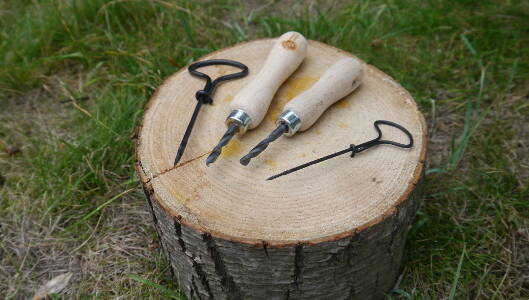
Palm drills are the perfect tools to start and practice the skill of drilling, helping to develop motor skills.
A palm drill is any drill held in the palm – including softwood hand drills.
Palm drills are used one-handed. They have an ergonomic handle and are light and easy to carry around.
This activity has been provided by

Consider the environmental impact of preparing, carrying out & completing this activity. Could this impact be reduced? Specific considerations for this activity could include:
Follow your usual operating procedures and carry out appropriate risk benefit assessments.
Some considerations particular to this activity include:
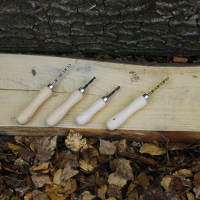
We have developed a range of palm drills including:
View our Palm Drills & Hand Tools here.
It’s a good idea to gradually build up the skill level when first using a palm drill.
Below we describe the technique of using a palm drill, with a step-by-step skill progression, followed by some examples of simple
starter projects.
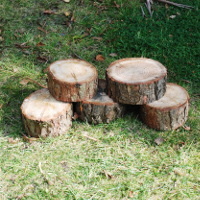
When using a palm drill it is advisable to drill onto a hard and level surface.
It is likely that the surface will get damaged as the drill goes through the object being drilled, so the surface may need to be protected.
When working outdoors use log rounds (pictured) as individual workstations.
Hold the wooden handle in the dominant hand and position the bit (metal drill part) vertically down.
Turn the drill in a clockwise direction whilst applying gentle downward pressure.
Tip – you may need to apply more pressure to get started.
As you turn the palm drill you will notice residue coming out of the hole – from time to time you may need to pull out the drill, clean it and clear the hole out – be careful – the edges are sharp (see Cleaning the drill below). You can then begin the drilling process again.
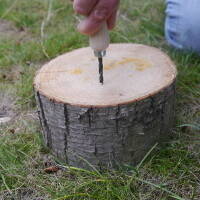
A good starting point is to drill into a large heavy item such as a log round. These are solid and should not move when being drilled, so the focus can be on the drilling action rather than holding the object.
When removing the drill ensure it comes out vertically – a sideways force on the drill torque could cause the drill to snap.
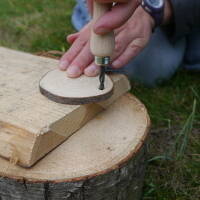
A simple progression is to then drill into a wooden disc – these are perfect to use as they are easy to hold steady on a log round. And being thin and flat, the drill doesn’t need to travel too far to finish the job.
To protect the work bench you can overlap the disc, as pictured, or put an old disc underneath the working piece.
Tip – you could drill a bigger hole into the work bench specifically to support this type of drilling.
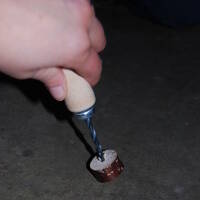
As children become more confident in using the palm drill, they can then try to hold a non-flat object like a noggin.
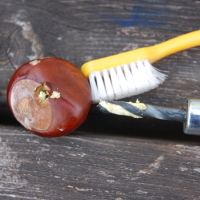
You may have to remove some of the debris from the hole (particularly if the wood is wet) by pulling the drill out of the item you are working on.
Twist as you remove the drill and tap off the wood shavings, or clean them off with a toothbrush.
Don’t be tempted to clean off with your fingers as the groove edges are sharp, as is the end of the softwood drill.
Softwood hand drills can also be used one-handed and are ideal for drilling smaller holes in wood, conkers, acorns and pith.
Softwood hand drills come in 2, 3 and 4 mm diameter, they require greater dexterity to hold and have a more pointed end compared to the palm drill.
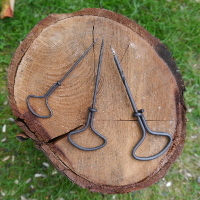
The technique is slightly different then the palm drill – using the fingertips rather than the palm to twist the drill, like twisting a key on a wind-up toy.
Tip: When items are a bit too small or slippy to hold try using a conker clamp. Once the item is clamped in position rest it on the work bench and and drill vertically down.

Drilling conkers
An easy introduction to drilling that can result in some amazingly creative pieces of art.
Read More about Drilling conkers
Drill a wooden disc
A simple and fun tool activity for young children using a rotary hand drill or a palm drill.
Read More about Drill a wooden disc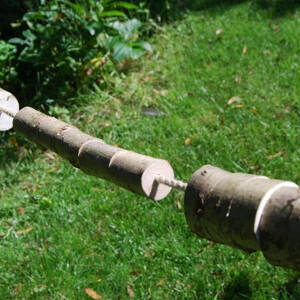
Make a counting rope
A great activity to practice fine motor skills and tool use ending up with an outdoor maths abacus.
Read More about Make a counting ropeDisclaimer: Muddy Faces cannot take any responsibility for accidents or damage that occurs as a result of following this activity.You are responsible for making sure the activity is conducted safely.